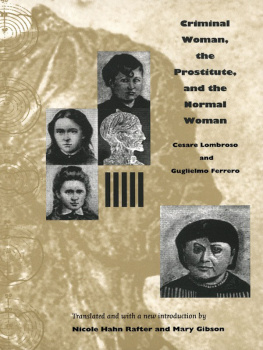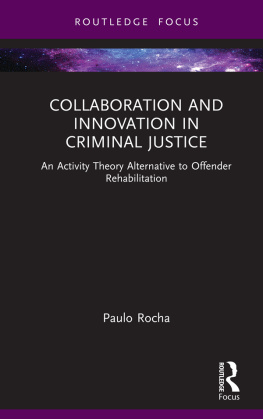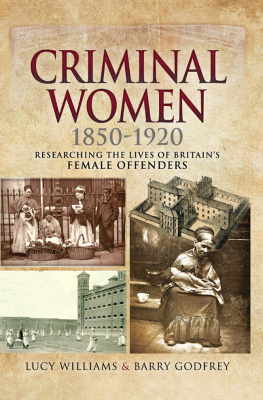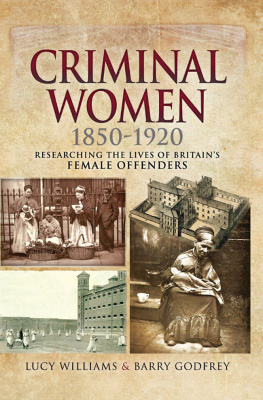Cesare Lombroso - The Female Offender
Here you can read online Cesare Lombroso - The Female Offender full text of the book (entire story) in english for free. Download pdf and epub, get meaning, cover and reviews about this ebook. year: 1980, genre: Romance novel. Description of the work, (preface) as well as reviews are available. Best literature library LitArk.com created for fans of good reading and offers a wide selection of genres:
Romance novel
Science fiction
Adventure
Detective
Science
History
Home and family
Prose
Art
Politics
Computer
Non-fiction
Religion
Business
Children
Humor
Choose a favorite category and find really read worthwhile books. Enjoy immersion in the world of imagination, feel the emotions of the characters or learn something new for yourself, make an fascinating discovery.

- Book:The Female Offender
- Author:
- Genre:
- Year:1980
- Rating:5 / 5
- Favourites:Add to favourites
- Your mark:
- 100
- 1
- 2
- 3
- 4
- 5
The Female Offender: summary, description and annotation
We offer to read an annotation, description, summary or preface (depends on what the author of the book "The Female Offender" wrote himself). If you haven't found the necessary information about the book — write in the comments, we will try to find it.
The Female Offender — read online for free the complete book (whole text) full work
Below is the text of the book, divided by pages. System saving the place of the last page read, allows you to conveniently read the book "The Female Offender" online for free, without having to search again every time where you left off. Put a bookmark, and you can go to the page where you finished reading at any time.
Font size:
Interval:
Bookmark:

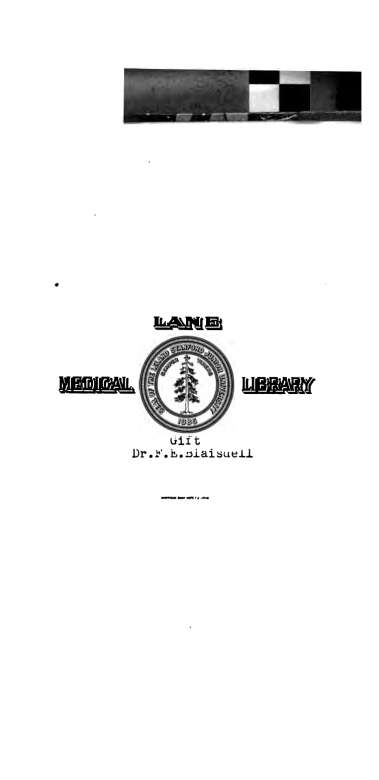
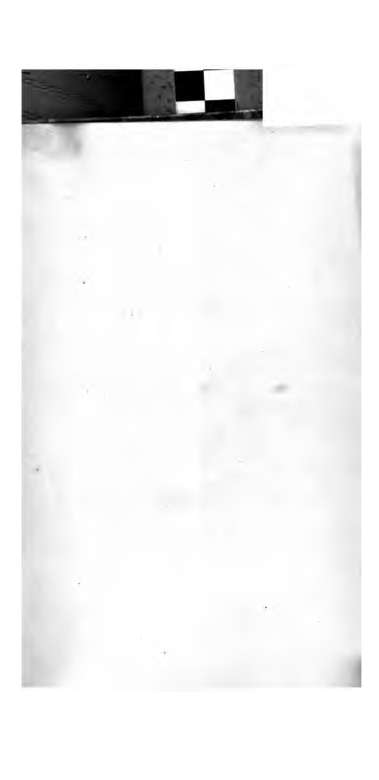
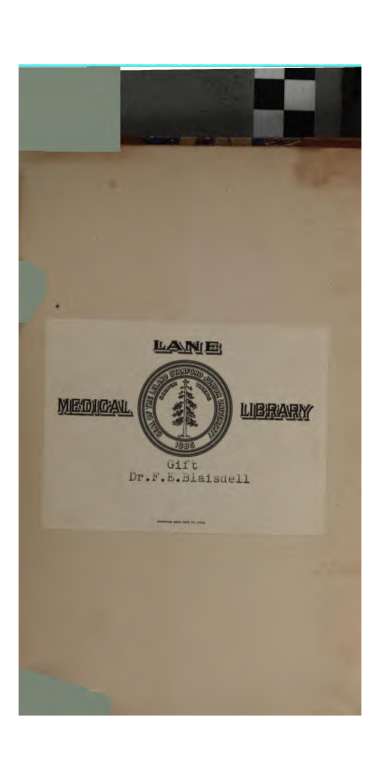

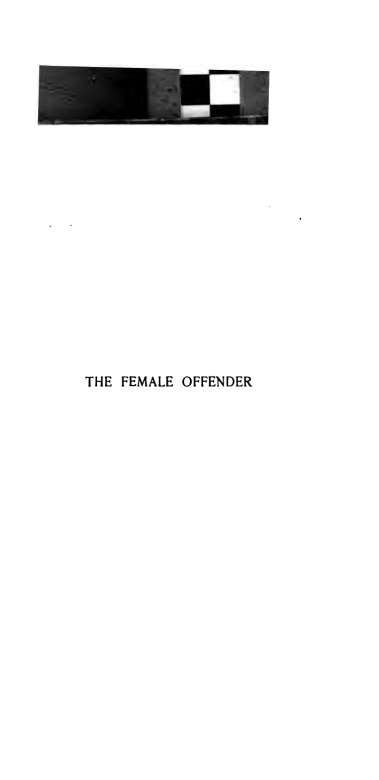
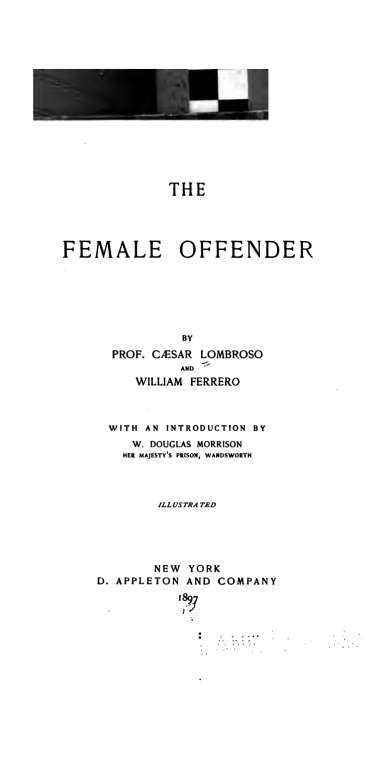
Authorized Eitition.

INTRODUCTION.
It is generally recognised that the supreme if not the exclusive object of criminal law and penal administration is the protection of society. Unfortunately it cannot be said at the present time that either criminal law or penal administration is fulfilling this object. In a recent comprehensive survey of criminal problems, Professor von Liszt, a distinguished German jurist, felt himself compelled to admit that our existing penal systems are powerless against crime. Similar expressions of opinion are of frequent occurrence among eminent specialists in France, Italy, and elsewhere ; and it is only because the question of crime has recently fallen into the background in Great Britain that the same confession of failure is not heard with equal emphasis among ourselves.
In order to be satisfied that these grave allegations are resting upon solid grounds of fact we have only to look at the increase of criminal expenditure and the growth of the habitual criminal population among all civilised communities. As far as Great Britain and the United States are concerned, the annual ofHcial expenditure in connection with crime amounts
V
00790
tNTttODUCTtO.t.
to i enormoiu sum. tn Great Britain t ture rcacfic!! a total of at least ten oiJIIions stcrli] per annum, and accofding to a recent report o( the Ohio Board of State Charities, the citizens of the United Stale* pciid an annual sum of fifty-nine million dollar* on judtdacy, police, prisons, and reformatories. What is tttc result of this vast annual drain on the resource of the nation ? Arc the people (getting an equivalent in the shape of a diminution in the numbers of the criminal classes? According to all the evidence we possess, it t to be feared tliat this il not the caM: Here are the words of General ItrinkerhofT, President of the National Prison Congress, as to the condition of affairs in tlic United States : "Other questions which agitate the public and divide parties arc doubtless important. But the country can live and prosper under free trade or protection, under kimelalliitm or monomctalli.sm, under Democracy or Republican ism, but it cannot survive a demoralised people with crime in the ascendant. That crime is on ihe increase out of proportion to the population is indicated in many wiiys, but for the counlry'as a whole, the United States census is the most reliable guide. Let us look at it by decades :
Vr. Pr^un.. Rutlo lo pop r-itioii.
1S50 6.737 mj.442
.890
j8<9
This rate of increase in a few states, we are glad to note, has not been maintained, and in one or two, for the higher crimes. It has even decreased a trifle ; but.
upon the whole, the swell has been continuous like a tide that has no ebb."
In the United Kingdom it is impossible to estimate the movement of the criminal population by a reference to the number of persons detained in prisons and convict establishments on a given day. Owing to the growing practice of committing juveniles to industrial institutions of all sorts ; owing to the substitution of fines for imprisonment ; and owing to the shortening of sentences, the prison population of Great Britain has not increased in the same manner as in the United States. But when the value of existing methods of penal administration is tested by the growth of the habitual offender we are confronted with a similar record of disastrous failure.
Why are our penal methods so helpless and discomfited in face of the criminal population ? Why do the combined efforts of legislators, judges, police, and prisons produce so few practical results ? Is it because the social disease with which these agencies are grappling is beyond the reach of human skill, and will continue to rage with unabated virulence so long as social life exists ? This deduction is hardly warranted by the facts. The failure of existing methods of criminal legislation and administration is not to be accepted as a proof that the organised forces of society are face to face with an incurable disease in the body politic. All that the failure of our present methods succeeds in establishing is the immediate and imperative necessity of placing our whole penal system upon a more rational foundation.
The collapse of penal legislation is to be accounted
VI ..,-....
fc/f tm SW: gr"u'.': ; '.-_- \-j - _. z-'^
which rt^ f^'.' t' / - - - -T ----
Ui*m^ir.:-'-\ ..; -:.-----_ ._ - ^i
\H Wi'-y ^: :_-:.- _ .L _ -:
A* fa' Ibe average member of tbc ammmity concerned, n 4 not to be denied that tfae fear of poni cofiKilucncn nuy exercite a Mlntaiy e&cE on Is imfMiltc* and reWvei al ooie critical ao m ea t is hi* career. To what extent ibe dicad of oxaa^ ttUn coIIUioa wlih Uiccriiiiirul law dctenntncs the canne of human action if in the nature at tliii^ hnpOBabic fj timatc. In any cue it taay sotdy be accepted that the ordin^y manthat is ta sxy, the man wf habitually lives under ordiiory sodai and biologKal oKiditifm* is on critical occanaos ddored from entertaining; ccnain kinds of anti-*ocial ideas by nn apprclicnxion that the practice of them will be followed by public indignation and public punbh-mcnL
If (he criminal populalioo was composed of ordinary men it is possible that tbc purely punitive principici on which tile penal code reposes would conttilute an cfhcicnt check on the icndcr>cy to crime, liut is it a fact that the criminal population la composed of ordinary men ? Is there any c^'idencc tf) Ikiw that the great army of offenders who are piiMn|T through our prisoiiM, penilcntianes, and penal Mtrvlludc exiabli.ihmcnts in a cea.selcs3 stream is made up of the wimc clcmcnlH as the law-abiding sections of Ihe community? On the contrary, there is every rmuon to believe that vast numbers of ihe criminal
population do not live under ordinary social and biological conditions. It is indeed a certainty that a high percentage of them live under anomalous biological and social conditions. And it is these anomalous conditions acting upon the offender either independently or, as is more often the case, in combination which make him what he is.
Penal laws pay exceedingly little attention to this cardinal and dominating fact. These laws assume that the criminal is existing under the same set of conditions as an ordinary man. They are framed and administered on this hypothesis ; and they fail in their operation because this hypothesis is fundamentally false. It is perfectly evident that a legislative and administrative system which is drawn up to meet one set of conditions will not be successful if in practice it is called upon to cope with a totally different set. A patient suffering from an attack of typhoid fever cannot be subjected to the same regimen, to the same dietary, to the same exercise as another person in the enjoyment of ordinary health. The regimen to which the patient is subjected must be suited to the anomalous condition in which he happens to be placed. Criminal codes to be effective must act upon precisely the same principle. They must be constructed so as to cope with the social and individual conditions which distinguish the bulk of the criminal population, and it is because they are not constituted upon this principle that these enactments are so helpless in the contest with crime.
Font size:
Interval:
Bookmark:
Similar books «The Female Offender»
Look at similar books to The Female Offender. We have selected literature similar in name and meaning in the hope of providing readers with more options to find new, interesting, not yet read works.
Discussion, reviews of the book The Female Offender and just readers' own opinions. Leave your comments, write what you think about the work, its meaning or the main characters. Specify what exactly you liked and what you didn't like, and why you think so.

